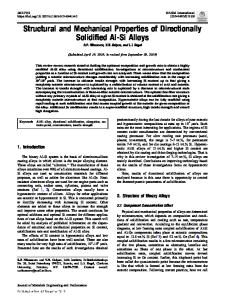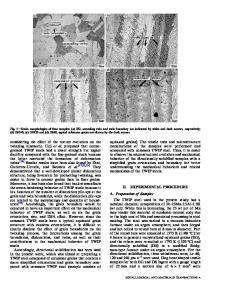Elevated temperature strength and room-temperature toughness of directionally solidified Ni-33Al-33Cr-1Mo
- PDF / 1,325,219 Bytes
- 13 Pages / 612 x 792 pts (letter) Page_size
- 12 Downloads / 292 Views
NTRODUCTION
NEW materials are required for the hot sections of the next generation of gas turbine engines. These materials must be able to withstand severe oxidizing conditions and relatively high stresses at temperatures at or exceeding 1300 K. Additionally, the materials must exhibit a tolerance for being handled and subjected to foreign object damage at low temperatures. Any new material, also, should have a lower density than current Ni-base superalloys to reduce the forces developed through rotation and to lower the overall weight of the engine. Based on these requirements, the B2 structure intermetallic NiAl is an attractive candidate for the development of new gas turbine engine material. Its density is about 75 pct of the value for superalloys, its congruent melting point is ⬃250 K higher than that of superalloys, and NiAl readily forms a protective, slow growing alumina oxide scale. Unfortunately, along with these positive characteristics, NiAl is weak at high temperatures and exhibits low fracture toughness at room temperature. The simultaneous improvement of elevated temperature strength and room-temperature toughness in NiAl is possible through directional solidification of NiAl-base eutectic alloys.[1–4] However, attainment of these benefits might require a perfectly aligned and fault free directionally solidified (DS) microstructure. In general, such ideal microstructures necessitate slow growth rates that lessen the commercial opportunities for gas turbine engine applications. As part of an effort at the Glenn Research Center to develop NiAl materials with acceptable toughness and strength values, several systems centered on the base NiAl34Cr (at. pct) eutectic composition are being studied in detail. This base alloy was selected because (1) Cr possesses some inherent oxidation resistance and a reasonably low density, (2) the eutectic melting point of the NiAl-34Cr J. DANIEL WHITTENBERGER, Materials Engineer, and S.V. RAJ, Materials Engineer, Materials Division, IVAN E. LOCCI, Principal Investigator, Materials Division, Case Western University Reserve University, and JONATHAN A. SALEM, Structural Engineer, Structures and Acoustics Division, are with the NASA-Glenn Research Center, Cleveland, OH 44135. Contact e-mail: [email protected] Manuscript submitted September 16, 2001. METALLURGICAL AND MATERIALS TRANSACTIONS A
eutectic is only about 150 K less than the ⬃1900 K congruent melting point for NiAl,[5] and (3) preliminary work[2] has shown that this eutectic possessed significantly improved 1300 K strength and room-temperature fracture toughness when compared to NiAl. The present article describes the results from roomtemperature fracture toughness and 1200 to 1400 K compressive testing of a Ni-33Al-33Cr-1Mo eutectic, which had been DS at rates ranging from 7.6 to 508 mm/h. This particular system was chosen because replacement of 0.7 at. pct or more Cr by Mo changes the morphology of the second phase from Cr fibers to Cr(Mo) plates,[6] which could improve both the fracture toughness
Data Loading...










